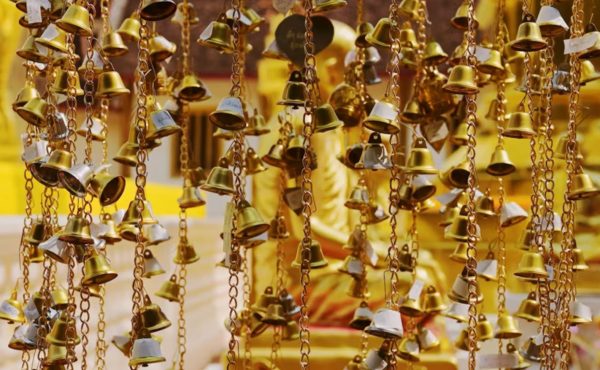Ah, passive-aggression. It’s the preferred conflict style of many an introverted arty type, myself admittedly included.
Despite being a fan of the technique, I’m a little perturbed to see it exemplified to a T (to taxpayer-and-public-spacer-expense) in the Art Gallery of Ontario’s latest outdoor signage.
If you look at the photo of that signage above, you’ll see the end of their large-print “We’ve closed up shop… for now” slogan followed by an overthunk admonition: “But feel free to visit the competition our friends: Bata Shoe Museum, Canadian Opera Company, Casa Loma, CN Tower, Gardiner Museum, National Ballet of Canada, Ontario Place, Ontario Science Centre, Royal Ontario Museum, Textile Museum of Canada, Toronto Symphony Orchestra, and Toronto Zoo”
At first I actually thought that the strikethrough and “our friends” scrawl was a witty graffito on the part of a Sharpie-toting copy editor. But no, it’s part of the original poster print. So apparently, this mixed message is what made it through the AGO’s own bureaucratic review chain as the acceptable way to publicly express its relationship to other Toronto museums and cultural institutions.
The result is a mode of parlance that maddens in the same way as any snotty-ex email might.
First, there’s the backhanded compliment. Is it a better thing to be off the list (and therefore off the AGO’s frenemy roster) completely, or is exclusion from same a snub? Dunno, might want to ask the Power Plant or the Museum of Contemporary Canadian Art or the Toronto Public Library or the University of Toronto or the Design Exchange next time you see them.
Second, there’s the self-congratulatory wit. Ha, ha, ha, really darling, now really—are we or aren’t we going to be civil when we bump into each other at Nuit Blanche or the Toronto International Art Fair this fall? Who knows, maybe I’ll get a special preview and you won’t, so it won’t matter! Ah, I kill myself.
Third (and this, the least snotty-ex-like part, is really the most maddening) it’s symbolic of how catty and uncooperative relationships can be between Toronto museums and institutions. I know I can well be accused of starry-eyed Montrealism from time to time, but here that town shows us up yet again. Why? Because despite whatever internal ill will surely exists on some level, they actually have a little something called the Board of Montreal Museum Directors, which unites institutions across the city in cross-promotional ventures like Montreal Museums Day. (FYI, Montreal Museums Day is an earth-shattering (by Toronto standards) event where all the museums in the city are free for one spring Sunday, with transit shuttle buses provided to ease travel.) Of late the BMMD has also launched a nifty all-museums pass that lets you visit 32 museums for 45 to 50 bucks.
I think this might be a good time to point out that while I’ve seen about a dozen “Visit the ROM” billboards in the past few days, I have yet, in 12 months of the Museums and Arts Pass program, to see a single billboard advertising that.
But… maybe I’m wrong. Maybe there really was a Sharpie-wielder somewhere out there who can prove my paranoia’s unwarranted. But as far as I’m concerned for now, this “small” ad gaffe is symbolic of a larger set of TO probs. Here we have million-dollar institutions behaving with the demeanor of gossipy, text-messaging, Hills-watching high schoolers. Like OMG ppl, WTF?




17 comments
meh, the marketing types are just trying to be edgy and “meta”. it doesn’t fit well, but they’re in the middle of trying to reinvent themselves. the sign may not be a classic, but i don’t think that’s news. at least it directs disappointed tourists elsewhere.
Hmmm blowing this way out of proportion. I’d expect this from Torontoist :(.
I saw this sign and did a double take; it’s a fascinating marketing strategy.
By the way, I visited Bata and the ROM before seeing the sign.
I wouldn’t!
The Museums and Arts Pass is promoted in your insurance statement.
Overreaction
Hmmm… I thought I was reading Torontoist when this first popped up on my Google reader…
Agreed, this is Torontoist material.
As for the Museum and Arts Pass, its targeted towards the prioirty neighbourhoods and the benefit of billboard/mass advertising would not fit the overall policy goals of the program.
Your “e-mail from an ex” analogy might be more apt than you realized: I think your “history” is causing you to read too much into this.
My guess is that it’s a good-natured, not perfectly executed attempt to poke fun at the corporate terminology (customers, market share, profitability, etc.) that’s forced upon cultural institutions these days.
The point of the list seems to be including all the most prominent tourist attractions in Toronto. None of the institutions you list I’d consider among the top common tourist destinations.
And how DO the AGO and, say, the Toronto Zoo co-operate in the lovey dovey Montreal way of things? Lend us a Rembrandt, we’ll send you an elephant?
Doesn’t an AGO membership offer discounts to local participating restaurants and a handful of other institutions?
As a non passive-aggressive arts worker, I’ve gotta ask: Where’s your sense of humour? There isn’t nearly as much hostility between the major arts org’s as you’d like to believe and the behind the scenes cooperation probably isn’t exciting enough to blog about. Even worse than the passive-aggressive are those who kill a joke by overanalyzing it to death. Is anyone else getting tired of the Montreal vs Toronto debate?
Congratulations AGO, I love your ad.
When I first read this poster – it made me laugh. Lighten up a bit! Life’s too short…
PS – FYI – there always seems to be much talk about taxpayers’ money when it comes to museums. But few people know only about a third of the revenue of most museums in Canada comes from government sources. The rest is obtained through admissions, special events, rentals, fundraising, museum shops, etc, etc. This is very much unlike Britain or France, for example, where large museums are 80-90% government funded. It would have been stronger and *smarter* to say “public money” because the bulk of revenue truly isn’t coming from taxes, but rather from public choice. Thanks!
I quite like Leah’s posts and critiques of the ROM and AGO, but this one is really petty.
I think Shira’s comment above hits it on the head.
MZ>Is anyone else getting tired of the Montreal vs Toronto debate?
I am. No doubt. Especially since it’s not a really debate between two parties; it’s a diatribe of one against the other.
Torontonians love Montreal and praise it at every opportunity.
Montrealers loathe Toronto and shit all over it at the merest provocation.
I don’t even say the word “bagel” around them anymore, lest I suffer through another tiresome wheeze about Montreal’s so-called superiority.
Montrealers: we love you, you’re great. Now please shut up and relax, which, after all, is supposed to be your “thing”.
Hey all,
Wow, I guess that in the eyes of Spacing readers, it sucks to be Torontoist. Not my point of view, but hey, you learn something new every day.
More than a few people have commented that this post is petty. I would reframe and say that this jibe on the part of the AGO is what’s really petty.
If you don’t believe there are political tensions behind the scenes of Toronto fests and institutions, go to a cultural conference one of these days and witness these tensions coming out in full. Listen to one institution express shock and outrage (off the record, mind you) at all of the funds another institution gets.
Also witness how these rebuilding and renovation schemes have pushed all of these institutions into a financial hole from which they will be paying (at least in terms of increased operating costs) for years to come. And as if the usual competition for private and public funding is not enough, these institutions are further pressured to keep and gain patrons just as–get this–a recession is hitting Ontario! They may support what each other are doing in theory but in practice they are all vying for a piece of an ever-shrinking financial pie. Of course they work together behind the scenes on various things but if there is no official structure to show for it, well I’d have to say that it’s likely a weaker setup than in other cities.
As for MOCCA, the Power Plant, etc. the comment was made that these are not on the same echelon as the AGO. This may be true in terms of holdings but not in terms of exhibiting art or in tourist attraction worthiness. Even before the AGO went into renovations both the MOCCA and the Power Plant became the key places in Toronto to see contemporary art. As many outside of Toronto have noted (http://www.canadianart.ca/art/features/2007/12/01/cross-country/) the last time the AGO wowed with a contemporary show was with Gerhard Richter back in 1988.
Also, I must admit I was greatly amused to see that recent NYT piece on Toronto highlight the MOCCA rather than the ROM (http://video.on.nytimes.com/?fr_story=3743d7b339227325510885d1bb4a0f98a4bf9a21) Why? Because it costs nothing to get into the MOCCA. Which still happens to be a priority for some travellers, whether or not the architecture is star-designed.
I tend to agree with Leah on both her article and her later remarks: museums in a city like Toronto probably would benefit from closer cooperation on common goals like accessibility, publicity, etc. Look at the BMMD page on their initiatives (http://www.museesmontreal.org/site/initiatives.htm) and strategy documents (http://www.museesmontreal.org/site/publications.htm).
And with an economic downturn in the offing, a.k.a. shrinking pie, that kind of *formal* common promotional organization will become increasingly important.
Sometimes the boards of cultural organizations look at everything through the eyes of business people–competition for resources, marketing pizazz, etc–that the cultural goals and content get less attention. But they’re the essence and reason for the institutions in the first place!
Ah yes, as long as it’s what the Times think … is it possible that one of the reasons they chose to highlight MOCCA is the ROM enjoys some ubiquity, and the Times might have wanted to provide a relatively “unknown” institution to its readers?
I’d also note that the AGO’s list does make an effort to reach beyond simply art, encompassing other fine arts as dance, music, and fashion. Notably, it doesn’t include any theatre venues. I find this a greater omission than any slight to contemporary art … of which the AGO itself does offer a collection, so perhaps it felt it should help to highlight the things it lacks entirely? Shoes, animals, textiles, music, dance?